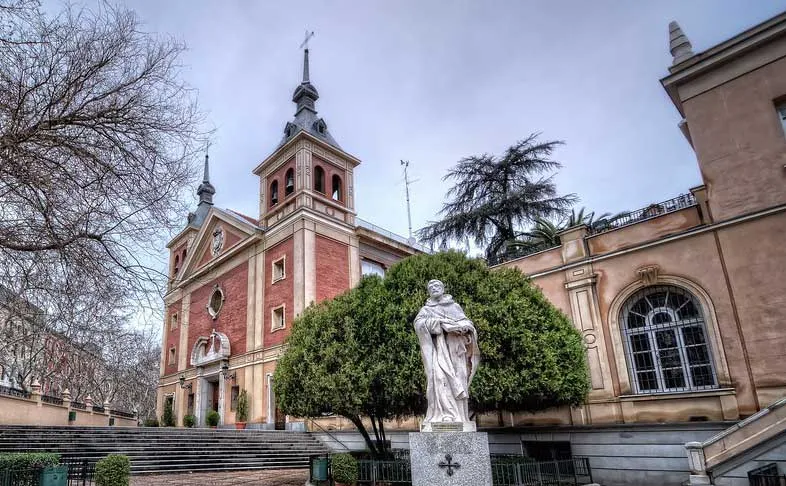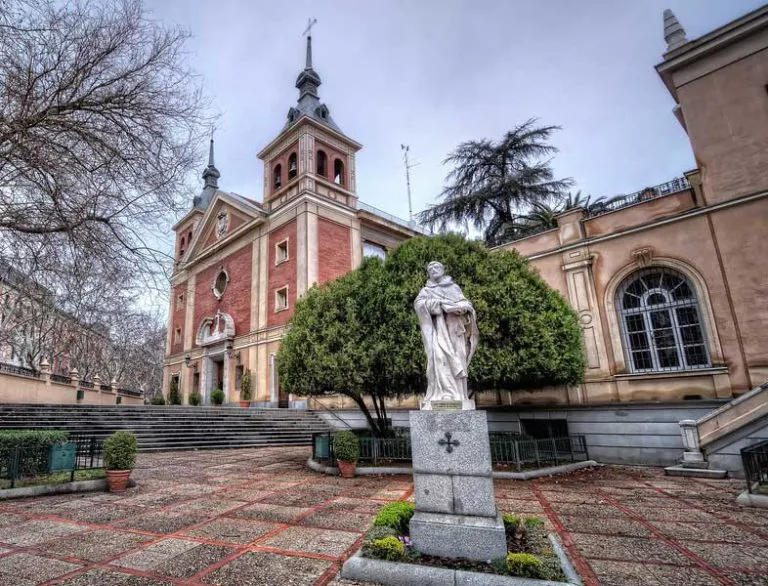
Introduction
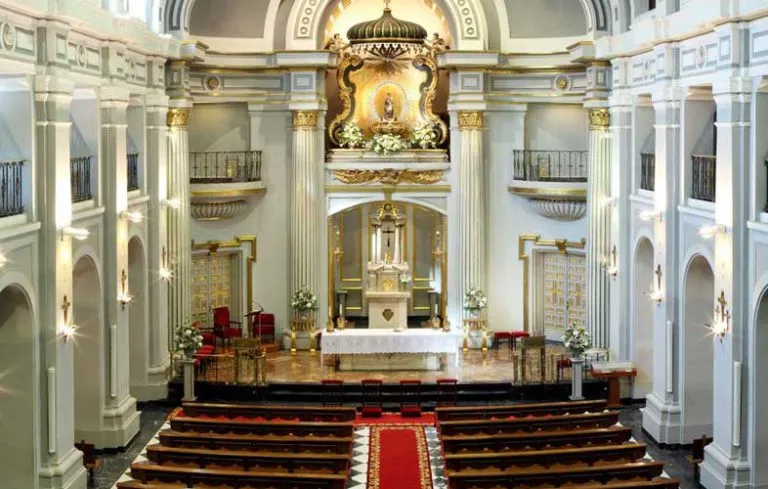
The Royal Basilica of Our Lady of Atocha or Real Basílica de Nuestra Señora de Atocha is a large church in central Madrid on Avenida de la Ciudad de Barcelona.
It is one of the six basilica churches in Madrid, alongside the Our Father Jesús de Medinaceli, San Francisco el Grande, St. Michael’s Basilica, Madrid, Basílica Hispanoamericana de Nuestra Señora de la Merced, and Church of La Milagrosa.
The buildings on the site have a long history. The original name refers to a lost icon from a chapel which was found among some high grasses -referred to as tocha- during the time of the Reconquista. The old church was in disrepair and rebuilt in the 1890s in a Neo-Byzantine style designed by Fernando Arbós y Tremanti. The church was destroyed during the Spanish Civil War and reconstruction completed in 1951.
Adjacent to the church is the Pantheon of Illustrious Men or Panteón de Hombres Ilustres of Madrid. It holds the remains of only a former president of the council of ministers, José Canalejas, however it also contains a number of interesting monuments from and just after the turn of the 19th century.
History of Basilica of Our Lady of Atocha, Madrid
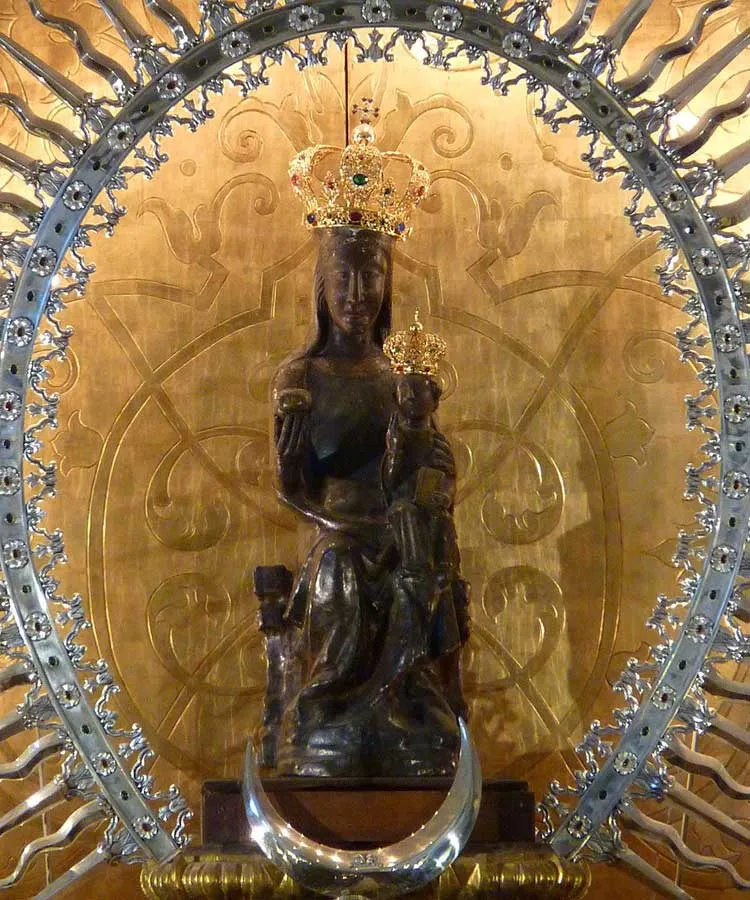
On November 12, 1863 , Pope Pius IX granted the title of Basilica to the church of Atocha , by means of a Pontifical Brief signed in Rome.
It had been Queen Elizabeth II who had submitted the request for said dignity to the Nuncio of His Holiness in Spain, Monsignor Barilli. The Queen was a faithful devotee of Our Lady of Atocha, and in her temple she had celebrated the wake mass for her marriage, and she went very often to pray and sing the Hail before the image of the Virgin. The Pope, aware of the Queen’s devotion to her image, promptly responded by granting her the title of Basilica.
This title is given to it due to the relevance that the temple has in the diocese due to its historical significance and the veneration of an image such as that of Atocha, which has had such relevance in the history of Madrid and Spain.
The community of Dominican friars of Atocha has as its first objective: to attend the cult of the Basilica, take care of the reception of the faithful, the administration of the sacrament of confession and promote devotion to Our Lady.
Our Lady of Atocha
The current image of Our Lady of Atocha is the oldest sculpture of the Virgin preserved in the city of Madrid. Due to its stylistic features it could be dated to the 13th century. It measures about 60 centimeters, and is made of polychrome wood. For many years the image was dressed in cloaks and the jewels that the monarchs and other faithful gave to the Basilica, hiding the original sculpture. This is how it continues to be done when a member of the Royal Family visits the temple, dressing the stature in a cloak gift from Isabel II and with the medallions of the Golden Fleece and the Order of Carlos III.
The Virgin appears seated, and holds her Son on her left knee. A type of image that wants to represent Mary as the Throne of Wisdom. This title reminds us, on the one hand, of her maternal function, because in her womb Christ, the Wisdom of the Father, has been formed and lived. On the other hand, her royal dignity, because her Son Jesus is the heir to the throne of David, the Messiah promised by God to the Jewish people.
And finally, she encourages us to give thanks for her wisdom and prudence, because Mary appears in the Gospel as the “wise virgin”, who has kept the words of Christ in her heart and offers them to the Church and to the world. world. The Child blesses with his right hand, extending the index and middle fingers, reminding us of the constant blessing to those who approach Him with faith.
The Name of Atocha
There are different versions about the origin of the name Atocha. Some consider that it refers to the supposed place of origin of the image, Antioch; Others believe that it comes from the Greek Theotokos (Mother of God), since on her throne you can read the Greek letters T and O; Lastly, and it is the most accepted hypothesis, the name would refer to the place where her hermitage was erected, where “atochas” (a plant similar to esparto grass) abounded. Therefore, Lope de Vega dedicated a poem to Our Lady of Atocha, wanting to highlight her humility.
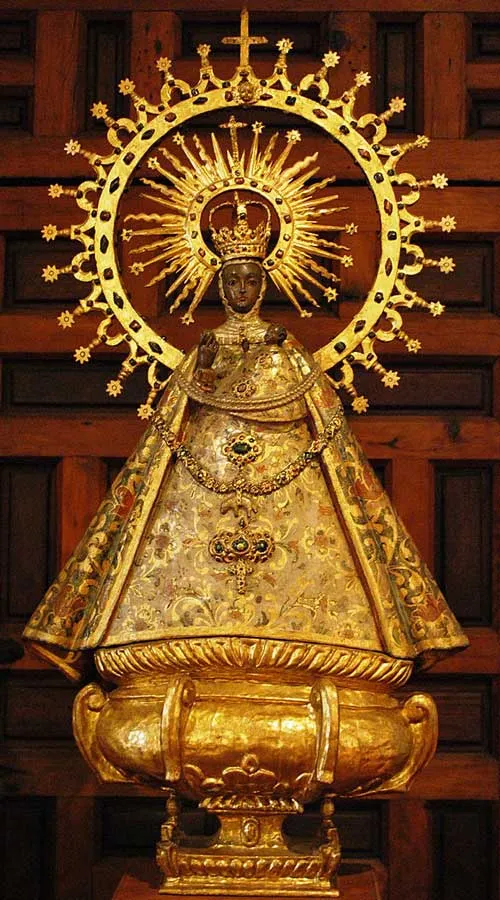
Our Lady of Atocha and the Royal Family
There has always been a close relationship between the Royal House and the image of Our Lady of Atocha.
According to the chronicles, the kings soon began to visit the Virgin of Atocha: Alfonso VII, Alfonso IX, Sancho IV the Brave, Enrique II, Enrique III, Enrique IV, Juan I, Juan II and the Catholic Monarchs.
The relationship was especially intense in times of the Habsburg dynasty and later with the Bourbons. The members of the Royal Family frequently attended their cults, they passed through their temple when leaving and entering Madrid.
It is said of Felipe II that he never left Madrid without going through the Basilica. Felipe IV visited it 3,400 times, as a friar of the house patiently noted. Carlos II wanted his first outing as King of Spain to go to Atocha, and he went there after his wedding with María Luisa de Orleans, giving away a mantle and a diamond crown on that occasion. Alfonso XII, restored to the throne, moved from the Atocha station to the Basilica where he prayed a Te Deum and the Salve.
Before the Disease of the Monarchs
When the monarchs suffered from a serious illness or were in the throes of death, the image of the Virgin was taken in a solemn procession to the Royal Palace. In fact, the image can only be processed if it is with royal permission. In 1562 he went out for the first time to ask for the health of Prince Charles who had suffered a fall. Felipe III and his son Felipe IV wanted to have her in his room at the time of his death
The Virgin of Atocha and the town of Madrid
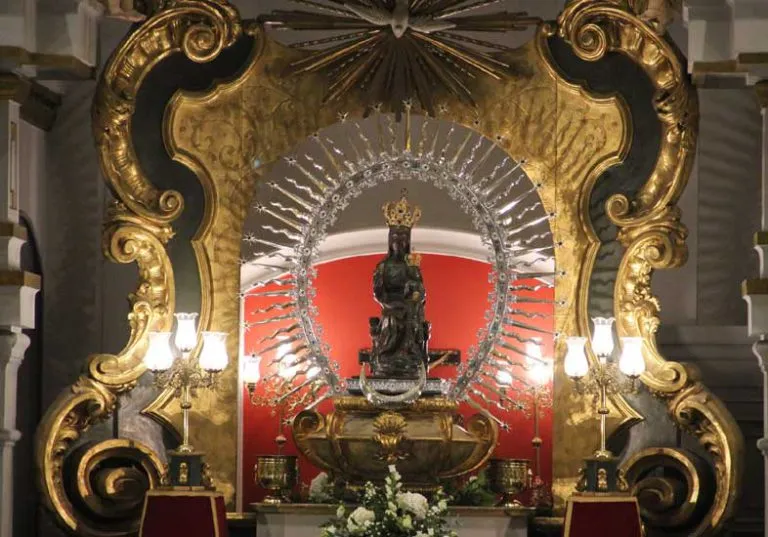
The city of Madrid has always had a great devotion to the Virgin of Atocha, in such a way that at some moments in history she was called “Patroness of the town”.
Even the chronicles say that an illustrious man from Madrid such as San Isidro Labrador came to pray before the image every day before going to work. On one occasion one of the children of San Isidro and Santa María Cabeza de Vaca fell into a well from which they could not get him out. Immediately the saint invoked the Virgin of Atocha and suddenly the water from the well rose up to the curb, taking the child out safe and sound.
Since then there have been many people from Madrid who, throughout history, have honored and pleaded with the Virgin of Atocha. Nobles, soldiers, clerics, farmers, citizens have approached her to implore mercy, ask for peace in times of war, water when there was drought, health in times of epidemics, protection in the face of tragedies.
The city resorted to the Virgin of Atocha in the most difficult moments, such as in 1580 when a terrible plague (they called it deadly cold) devastated the city, and in that moment of despair the people, clergy, religious, Villa, Councilors, Kingdom, Grandees, Princes and the entire region went to the Sanctuary of Atocha taking out in procession the image that spent three days in the parish of Santa María, three in Santo Domingo el Real and another three in Las Descalzas. The disease subsided and as a thank you, she vowed for five years with the obligation to attend the Annunciation festival.
And some time later, in July 1631, a terrible fire consumed entire blocks around the Plaza Mayor in Madrid. Heaven’s help was immediately requested and for this reason the monarch asked that the image of Our Lady of Atocha be taken in procession to the Plaza Mayor and later to the Descalzas Reales where the Court and the Kings were located, so that their presence put out the fire. The fire ceased and was attributed to divine intervention.
A Troubled Story
Since the 19th century, the image and the temple of Atocha have suffered terrible events of a different nature.
In 1808 Napoleon’s troops violently entered the Convent and church, turning it into a barracks and causing terrible damage. It was then that the historic flags, a reminder of Spanish triumphs throughout history, which decorated the walls of the temple as a sign of gratitude, were lost. They stole all the gold and silver from the Virgin, burned the books in the library, and demolished numerous parts of the convent. The friars removed the image of Our Lady and took it to the Descalzas Reales and later transferred it to the Convent of Santo Tomás where the religious stayed.
The confiscation of 1834 was the second hard blow to the temple, when the Dominicans were expelled and the convent turned into a barracks for invalids and the temple guarded by the Royal Chaplain. With the passage of time the temple threatened ruin and the image was transferred to the parish of Buen Suceso.
The First Basilica of Madrid
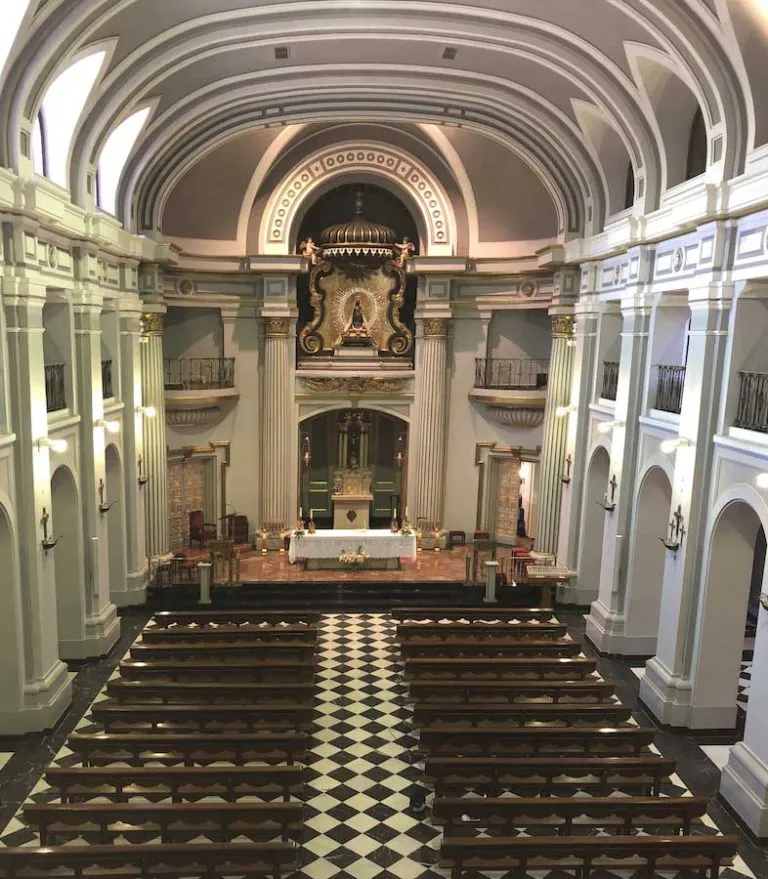
On November 12, 1863, Pope Pius IX granted the church of Atocha the title of Basilica, by means of a Pontifical Brief signed in Rome. Thus, it became the first temple in Madrid to receive this title and one of the top ten in Spain.
It had been Queen Elizabeth II who had submitted the request for said dignity to the Nuncio of His Holiness in Spain, Monsignor Barilli. The Queen was a faithful devotee of Our Lady of Atocha, and in her temple she had celebrated the wake mass after her marriage, and she went very often to pray and sing the Hail before the image of the Virgin. The Pope, aware of the Queen’s devotion to her image, promptly responded by granting her the title of Basilica.
The Royal Basilica of Atocha was for 10 years, from 1878 to 1888, as the seat of the Parish of Nuestra Señora de las Angustias. As a fact of interest we can state that, in 1883, the great Madrid philosopher Mr. José Ortega y Gasset was baptized there.
Restoration
In 1924 the Dominicans, who could not forget the Virgin of Atocha that they had guarded with such devotion and affection for four centuries, asked King Alfonso XIII to grant facilities to restore the convent and church of the Virgin of Atocha. The works were carried out as quickly as possible and on the first Saturday of November 1926 the Virgin was solemnly transferred from the parish of Buen Suceso to her new church, where she was received by His Majesty the King and his mother, Queen María. Cristina, resuming a new era in the cult of the Virgin of Atocha.
The cult was again interrupted in the eventful years of our civil war, when the convent and the church were assaulted and burned – on July 20, 1936 – and the religious who could not escape that tragic day were martyred. Everything of value was lost in the enclosure but God wanted that only the greatest treasure of the house could be saved, the image of the Virgin of Atocha that had been removed days before from her throne and had been delivered for safekeeping to a family friend of the Community.
In 1939, taking advantage of the solid main walls that had remained standing after the fire, among the ruins, the basement room was turned into a chapel and in that kind of catacomb the Virgin once again occupied her simple and humble throne.
A New Stage
The current temple was inaugurated on Christmas 1951, and is the work of Diego Méndez. A new community was then established in the Atocha Convent and a new period of great religious, pastoral and educational activity began. In 1963 the Virgen de Atocha College was built, which the Atocha community managed for more than 40 years until it passed to the Santo Domingo Educational Foundation, although friars from the convent continue to participate in the College’s pastoral care. In 1965 the parish of Nuestra Señora de Atocha was erected, which meant a great pastoral impulse in the neighborhood that continues today with intensity.
The link between the Royal House and the Basilica has also been maintained during the 20th century. The current kings Felipe VI and Doña Leticia went to the temple after their wedding to present the bouquet to the Virgin, and on two more occasions to present their two daughters, the current princess Leonor and the infanta Sofía, before their patron saint.
Feast Day - 26th January
Nuestra Señora de Atocha / Our Lady of Atocha / Our Lady of Long Fields, Madrid, Spain (1261) and Memorials of the Saints – 26 January
Mass Time
Weekdays
Saturdays
Sundays
Church Visiting Time
Contact Info
Av. de la Ciudad de Barcelona,
1, 28007, Madrid, Spain
Phone No.
Tel : +34 914 34 40 20
Accommodations
How to reach the Basilica
Adolfo Suárez Madrid–Barajas Airport commonly known as Madrid–Barajas Airport in Madrid, Spain is the nearby Airport to the Basilica.
Atocha Metro Station in Madrid, Spain is the nearby Train Station to the Basilica.

